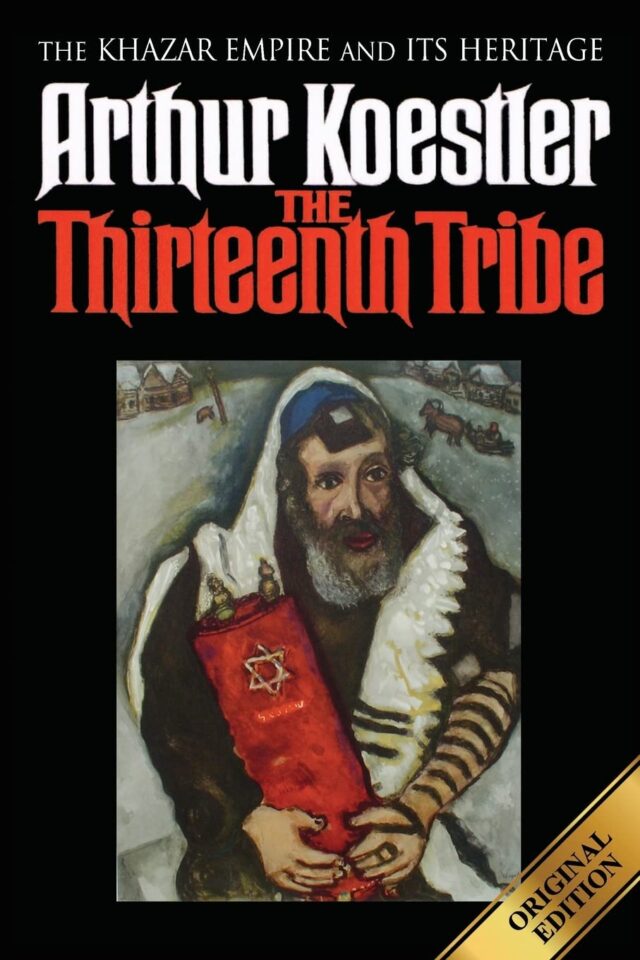Arthur Koestler’s The Thirteenth Tribe is a provocative historical study that explores the origins and history of the Khazars, a Turkic people who established a powerful empire in Eastern Europe between the seventh and tenth centuries AD. The book’s central thesis is that the Khazars, who converted en masse to Judaism around the eighth century, may have significantly contributed to the ancestry of modern Ashkenazi Jews. This idea challenges traditional narratives about Jewish origins and has sparked considerable debate. Koestler draws on historical, archaeological, and linguistic evidence to argue that the Khazar Empire was pivotal in shaping medieval Europe and the Jewish diaspora. Below is a comprehensive 5,000-word summary of the book, covering its key arguments, historical context, and implications.
Introduction and Context
Arthur Koestler, born in Budapest in 1905, was a prolific writer and intellectual known for his works on politics, science, and history. His diverse experiences as a journalist, soldier, and former Communist Party member inform his analytical approach in The Thirteenth Tribe. Published in 1976, the book reflects Koestler’s fascination with the interplay of history, identity, and culture. It also emerges from his broader interest in challenging established narratives, a theme evident in his earlier works like Darkness at Noon.
Koestler begins by noting the scarcity of mainstream historical attention to the Khazars, despite their significant influence in medieval Europe. He argues that their story has been overshadowed by more prominent narratives of Western and Islamic history. The book’s title, The Thirteenth Tribe, refers to the Khazars as a distinct group among the Jewish people, separate from the twelve tribes of ancient Israel. Koestler’s central question is whether the Ashkenazi Jews, who form the majority of modern Jewry, are primarily descended from the Khazars rather than from the Judeans of antiquity.
Chapter One: Rise and Fall of the Khazars
Rise of the Khazar Empire
Koestler opens with a vivid description of the Khazar Empire, which flourished between the Caucasus Mountains and the Volga River from the seventh to the tenth centuries. At its height, the empire controlled a vast territory, including parts of modern-day Russia, Ukraine, and the Caucasus. The Khazars were a Turkic people, originally nomadic, who transitioned into a semi-sedentary society with urban centers like Itil (their capital) and Sarkel. Their economy thrived on trade, agriculture, and tribute from neighboring tribes. Koestler cites the tenth-century Arab geographer Muqaddasi, who noted the abundance of sheep, honey, and furs in Khazaria, underscoring its prosperity.
The Khazars’ strategic location made them a buffer state between the Byzantine Empire and the Islamic Caliphate. They played a crucial role in preventing the spread of Islam into Eastern Europe by repelling Arab invasions in the seventh and eighth centuries. Koestler emphasizes the Khazars’ military prowess and diplomatic acumen, which allowed them to maintain independence amid powerful neighbors. Their rulers, known as khagans, wielded significant authority, and their court was a hub of cultural and religious exchange.
Conversion to Judaism
The most striking aspect of Khazar history, according to Koestler, is their mass conversion to Judaism around the eighth century. This event, documented in medieval sources like the Hebrew-Khazar Correspondence and the writings of Arab chroniclers such as al-Masudi, is central to the book’s argument. Koestler suggests that the Khazars adopted Judaism as a neutral religion to maintain political independence from both Christian Byzantium and the Muslim Caliphate. Unlike Christianity or Islam, Judaism was not associated with a rival empire, making it an appealing choice.
The conversion began with the Khazar elite and gradually spread to the broader population. Koestler draws on the Kitab al-Khazari by Jehuda Halevi, a medieval Jewish philosopher, which describes the conversion as a deliberate and philosophical choice. The Khazar khagan, after debating representatives of Judaism, Christianity, and Islam, reportedly chose Judaism for its monotheistic purity and historical depth. Archaeological evidence, such as Hebrew inscriptions and Jewish symbols found in Khazar sites, supports the narrative of widespread Judaization.
Fall of the Khazar Empire
The Khazar Empire began to decline in the tenth century due to internal strife and external pressures. The rise of the Kievan Rus, a powerful Slavic state, posed a significant threat. In the 960s, the Rus prince Svyatoslav I launched a devastating campaign against the Khazars, sacking Itil and other key cities. Koestler notes that the Khazars’ nomadic origins made their state vulnerable to such assaults, despite their earlier success in urban development.
The empire’s collapse was also hastened by the weakening of the Caliphate, which reduced the Khazars’ strategic importance as a buffer state. By the eleventh century, the Khazar Empire had fragmented, and its people dispersed. Some Khazars integrated into neighboring societies, while others migrated westward, potentially contributing to the Jewish communities of Eastern Europe. Koestler argues that this diaspora laid the foundation for the Ashkenazi Jewish population.
Chapter Two: The Khazar Legacy
Khazar Society and Culture
Koestler challenges the stereotype of the Khazars as mere nomadic warriors, drawing on Soviet archaeological findings to depict a sophisticated society. Excavations revealed large villages with houses connected by galleries, advanced irrigation systems, and evidence of viticulture and craftsmanship. The Khazars were not a “whirlwind” like the Huns, as nineteenth-century orientalist Cassel suggested, but a stable civilization with a complex economy.
The Khazars’ religious pluralism was another hallmark of their society. While Judaism became the state religion, Christian, Muslim, and pagan communities coexisted under Khazar rule. This tolerance fostered cultural exchange, evident in the Khazars’ adoption of Hebrew script and their correspondence with Jewish scholars in Spain and Byzantium. Koestler highlights the Hebrew-Khazar Correspondence, a series of letters between Khazar leaders and Spanish Jewish officials, as evidence of the Khazars’ integration into the Jewish world.
The Khazar Diaspora
After the fall of their empire, the Khazars dispersed across Eastern Europe, the Caucasus, and Central Asia. Koestler posits that many Khazar Jews migrated to regions like Poland, Hungary, and Ukraine, where Jewish communities later flourished. He points to linguistic and cultural clues, such as the prevalence of Turkic words in Yiddish and the absence of Semitic features in Ashkenazi Jewish populations, to support his hypothesis.
Koestler acknowledges the scarcity of direct evidence linking the Khazars to the Ashkenazi Jews, given the destruction of Khazar records during the Rus invasions. However, he argues that the rapid growth of Jewish communities in Eastern Europe during the Middle Ages is difficult to explain without a significant influx of non-Judean Jews, such as the Khazars. He contrasts this with the traditional view that Ashkenazi Jews are primarily descendants of Judean exiles who migrated from the Middle East to Europe via the Mediterranean.
Chapter Three: Implications for Jewish Identity
Challenging the Semitic Narrative
Koestler’s most controversial argument is that the Ashkenazi Jews are predominantly of Khazar, rather than Semitic, origin. He contends that the traditional narrative of Jewish descent from the ancient Israelites is a “misapprehension” that has fueled anti-Semitism. If the Ashkenazi Jews are largely Khazar descendants, Koestler argues, the term “anti-Semitism” becomes meaningless, as it implies prejudice against a Semitic race that many Jews do not belong to.
This thesis is grounded in historical and anthropological evidence. Koestler cites studies by scholars like Hugo von Kutschera and Joseph Jacobs, who noted the physical and cultural differences between Ashkenazi Jews and their Sephardic counterparts. He also draws on the work of A.N. Poliak, who argued that the Khazar conversion significantly shaped Eastern European Jewry. Koestler suggests that the Khazars’ Turkic ancestry explains the distinct characteristics of Ashkenazi Jews, such as their fair complexions and Turkic linguistic influences.
The “Cruel Hoax” of History
Koestler describes the Khazar story as “the most cruel hoax which history has ever perpetrated,” referring to the marginalization of the Khazars in historical narratives and the persistence of the Semitic origin myth. He argues that acknowledging the Khazar contribution to Jewish identity could reduce anti-Semitic stereotypes by decoupling Jewishness from a specific racial or ethnic origin. This, in turn, would emphasize Judaism as a cultural and religious tradition rather than a genetic lineage.
However, Koestler is careful not to dismiss the spiritual and historical significance of Jewish identity. He recognizes the continuity of Jewish culture through practices like the Torah and the Talmud, regardless of ethnic origins. His goal is not to undermine Jewish identity but to broaden its historical context and challenge racially motivated prejudices.
Chapter Four: Historical Sources and Evidence
Koestler relies on a wide range of sources to support his arguments, including medieval chronicles, archaeological findings, and modern scholarship. Key texts include:
- Arabic and Persian Sources: Chronicles by al-Masudi, Ibn Hawkal, and Muqaddasi provide detailed accounts of Khazar society, economy, and religion. These sources confirm the Khazars’ Jewish identity and their role as a regional power.
- Byzantine Records: The writings of Photius and the Russian Primary Chronicle document the Khazars’ interactions with Byzantium and the Rus, highlighting their diplomatic and military significance.
- Jewish Texts: The Hebrew-Khazar Correspondence and Jehuda Halevi’s Kitab al-Khazari offer insights into the Khazars’ conversion and their integration into the Jewish world.
- Archaeological Evidence: Soviet excavations in the 20th century uncovered Khazar settlements, fortifications, and artifacts with Hebrew inscriptions, corroborating the literary sources.
Koestler acknowledges the limitations of these sources, particularly the scarcity of Khazar-authored texts. The destruction of Khazar records during the Rus invasions and the nomadic nature of their early society left gaps in the historical record. Nevertheless, he argues that the cumulative evidence strongly supports the Khazars’ Jewish identity and their influence on Eastern European Jewry.
Chapter Five: Critiques and Controversies
Koestler anticipates criticism of his thesis, particularly from those who view the Semitic origin narrative as central to Jewish identity. He addresses potential objections, such as the lack of definitive genetic evidence linking the Khazars to the Ashkenazi Jews. At the time of the book’s publication, genetic studies were rudimentary, and Koestler relies instead on historical and cultural evidence.
Another critique is that Koestler’s argument could be misused to undermine Jewish legitimacy or fuel anti-Semitic narratives. Koestler counters this by emphasizing that his goal is to combat racial prejudice, not to question Jewish cultural continuity. He also notes that the Khazars’ conversion to Judaism was a genuine and voluntary act, making them as “Jewish” as any other Jewish community.
Koestler’s work has been both praised and criticized by scholars. Supporters, like A.N. Poliak, commend his effort to highlight the Khazars’ historical significance. Critics, however, argue that he overstates the Khazar contribution to Ashkenazi ancestry and underestimates the role of Judean migrations. Subsequent genetic studies, conducted after Koestler’s death, have produced mixed results, with some supporting a partial Khazar influence and others emphasizing Middle Eastern origins.
Conclusion
The Thirteenth Tribe is a bold and thought-provoking exploration of the Khazar Empire and its potential impact on Jewish history. Koestler’s central thesis—that the Ashkenazi Jews are largely descended from the Khazars—challenges conventional narratives and invites readers to reconsider the complexities of Jewish identity. By situating the Khazars within the broader context of medieval Europe, Koestler highlights their role as a bridge between East and West, Christianity and Islam, and nomadism and urbanism.
The book’s strength lies in its interdisciplinary approach, combining historical texts, archaeological evidence, and anthropological insights. While some of Koestler’s conclusions remain speculative, his work has sparked valuable debate about the fluidity of ethnic and religious identities. The Thirteenth Tribe also serves as a critique of racial determinism, urging readers to view Jewishness—and human identity more broadly—as a product of culture, history, and choice, rather than biology alone.
Koestler’s legacy in The Thirteenth Tribe is one of intellectual courage and historical curiosity. By resurrecting the story of the Khazars, he not only enriches our understanding of medieval history but also challenges us to question the myths that shape our perceptions of the past. Whether or not one accepts his Khazar hypothesis, the book remains a compelling testament to the power of history to reshape our understanding of identity and belonging.
Bibliography
The book concludes with an extensive bibliography, listed in part on pages 98–99 of the provided document. Key sources include:
- Gibbon, E., The History of the Decline and Fall of the Roman Empire (1901).
- Halevi, J., Kitab al-Khazari (1931).
- Poliak, A.N., Khazaria – The History of a Jewish Kingdom in Europe (1951).
- Russian Primary Chronicle, trans. Cross, S.H., and Sherbowitz-Wetzor, C.P. (1953).
- al-Masudi, Muruj udh-Dhahab wa Maadin ul-Jawahir (1861–77).
These references underscore Koestler’s reliance on primary and secondary sources to construct his narrative, ensuring a robust foundation for his arguments.










